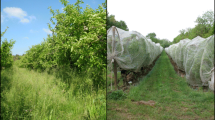Abstract
Knowledge on the natural enemies of graminaceous stem borers is outlined, with special reference to mortality of Chilo spp. as crop pests in Africa. The quantitative scanty information available suggests that over 90% mortality of eggs and larvae takes place before the larvae become established as borers in the crop and that mortality of the older larvae and pupae is much lower. Possible manipulations of natural enemies to increase mortality further are reviewed. In view of the largely negative results of past classical biological control introductions the prospects do not appear very promising. However, the results do indicate some possibilities which should be investigated, notably trials with Apanteles spp. (Braconidae) and intra-continental redistribution of important species with restricted distributions. For short-term biological control, development of microbial biopesticides seems a more promising strategy than augmentation of insect parasitoids by breeding and release, particularly on small farms. A third possibility, enhancement of the action of native natural enemies by environmental manipulation, merits more attention as part of an integrated crop production approach to the improvement of the quantity and reliability of yields for the small farmer.
Résumé
La connaissance des ennemis naturels des foreurs des graminées cultivées est delimitée par reférence particulière à la mortalité de Chilo spp. comme ravageurs des plantes cultivées en Afrique. Les renseignements quantitatifs sont maigres, mais ils indicent que plus de 90% mortalité des oeufs et larves s’arrive avant de leurs établissement comme les foreurs dans la plantation, et que la mortalité des larves plus vieux et des imagos est beaucoup plus basse. Les manipulations possibles des ennemis naturels pour augmenter la mortalité sont examinées. En considération des résultats, en grande partie negatif, des introductions d’autrefois pour la lutte biologique, l’avenir ne s’annonce pas bien. Cependant, les résultats indicent des possibilités ceux qui on doit investiger, notamment les essais avec Apanteles spp. (Braconidae) et rédistribution intercontinentale des espèces importantes ayant les distributions limitées. Pour la lutte biologique à court terme la développement des biopesticides microbiales serais une strategie qui promet beaucoup que l’augmentation des insectes parasitoides par l’élevage et la libération, particulièrement dans les fermes plus petites. Une possibilité troisième, l’enchérissement de l’action des ennemis naturels indigènes par la manipulation de l’environment se merite plus d’attention comme une partie d’une rapprochement integrée au production des plantes cultivées à l’amélioration de la quantité et la reliabilité des rendements pour le cultivateur de la petite ferme.
Similar content being viewed by others
References
Altieri M. and Letourneau D. K. (1982) Vegetation management and biological control in agroecosystems. Crop Prot. 1, 405–430.
Berger A. (1981) Biological control of the spotted stalkborer, Chilopartellus (Swinhoe) in maize by using the bacteria Bacillus thuringiensis. FAO Field Document AG: DP/MOZ/75/009.
Betbeder-Matibet M. (1989) Biological control of sorghum stem borers. International Workshop on Sorghum Stem Borers, 17–20 Nov. 1987. ICRISAT Center, India, pp. 89–93.
Bordat D., Brenière J. and Coquard J. (1977) Foreurs de graminées africaines: parasitisme et techniques d’élevage. Agron. Trop. 32, 391–399.
Chapman R. F., Woodhead S. and Bernays E. A. (1983) Survival and dispersal of young larvae of Chilo partellus (Swinhoe) (Lepidoptera: Pyralidae) in two cultivars of sorghum. Bull, entomol. Res. 73, 65–74.
Cock M. J. W. (Ed) (1985) A review of biological control of pests in the Commonwealth Caribbean and Bermuda up to 1982. Tech. Commun. Commonw. Inst. Biol. Contr., No. 9.
Easwaramoorthy S. and Nandagopal V. (1986) Life tables of internode borer, Chilo sacchariphagus indicus (K.) on resistant and susceptible varieties of sugar-cane. Trop. Pest Manage. 32, 221–228.
Girling D. J. (1972) Report on investigations on graminaceous stem borers in East Africa (November 1969-March 1972). Commonw. Inst. Biol. Contr. Rep.
Greathead D. J. (1989) Crop protection without chemicals: pest control in the third world. Asp. Biol. 17, 19–28.
Harris K. M. (1989) Bioecology of sorghum stem borers. In Proceedings of the International Workshop on Sorghum Stem Borers, 17–20 Nov. 1987. ICRIS AT Center, India, pp. 63–71.
Ingram W. R. (1983) Biological control of graminaceous stem borers and legume pod borers. Insect Sci. Applic. 4, 205–209.
Jai Rao K. and Baliga H. (1986) Sturmiopsis infer ens Towns., a tachinid parasite of sugarcane and paddy stem borers. Tech. Bull. Commonw. Inst. Biol. Contr. 10, 33–48.
Mathez F. C. (1972) Chilo partellus Swinh., C. orochalcociliella Strand (Lep., Crambidae) and Sesamia calamistis Hmps. (Lep., Noctuidae) on maize in the Coast Province, Kenya. Mitt Schweiz. Entomol. Ges. 45, 267–289.
Mohyuddin A. I. (1990) Utilization of natural enemies for the control of insect pests of sugarcane. Insect Sci. Applic. 12, In press.
Mohyuddin A. I. and Greathead D. J. (1970) An annotated list of the parasites of graminaceous stem borers in East Africa, with a discussion of their potential in biological control. Entomophaga 15, 241–274.
Mohyuddin A. I., Inayatullah C. and King E. G. (1981) Host selection and strain occurrence in Apanteles flavipes (Cameron) (Hymenoptera: Braconidae) and its bearing on biological control of graminaceous stem borers (Lepidoptera: Pyralidae). Bull, entomol. Res. 71, 575–581.
Omolo E. O. (1990) Multiline intercropping for the management of Chilo partellus. (This symposium), Discovery and Innovation 2, 103–106.
Van Hamburg H. (1980) The grain sorghum stalk-borer, Chilo partellus (Swinhoe) (Lepidoptera: Pyralidae): Survival and location of larvae at different infestation levels in plants of different ages. J. Entomol. Soc. S. Afr. 43, 71–76.
Van Hamburg H. and Hassell M. P. (1984) Density dependence and the augmentative release of egg parasitoids against graminaceous stalk borers. Ecol. Entomol. 9, 101–108.
Author information
Authors and Affiliations
Rights and permissions
About this article
Cite this article
Greathead, D.J. Utilization of Natural Enemies of Chilo spp. for Management in Africa. Int J Trop Insect Sci 11, 749–755 (1990). https://doi.org/10.1017/S1742758400021305
Received:
Revised:
Published:
Issue Date:
DOI: https://doi.org/10.1017/S1742758400021305



